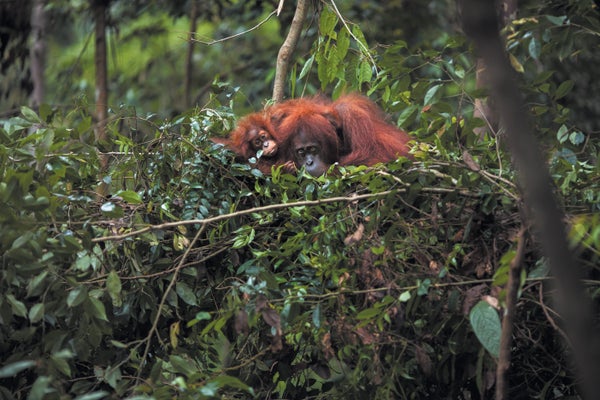How Baby Orangutans Become Master Treehouse Architects
Most orangutans take seven years to learn to make their own beds

An orangutan and her daughter in their day nest.
Orangutans are known for an impressive feat of engineering: They carefully weave an intricate nest from branches and leafy twigs in the forest canopy daily, building and rebuilding for cozy nights and shady midday naps. Some nests, particularly those made by older and more experienced orangutans, feature pillows, linings, blankets, and sometimes even a roof fashioned from broad leaves—and all must be well protected from the elements and strong enough to hold 100-plus pounds of slumbering ape.
Now a study published in Animal Behaviour reveals that young orangutans perfect this vital task over the course of seven years. “The fact that it takes them so long to acquire this skill shows us that it’s much more complex than we realized before,” says the study’s lead author Andrea Permana, a primatologist at the University of Warwick in England.
To understand this behavior, researchers followed 45 orangutans at Indonesia’s Gunung Leuser National Park for 13 years. “It was very cool to see more focus on material culture and tool-use behavior that isn’t the standard ‘sticks and stones,’ like the caveman tools that we usually focus on,” says University of Kent primatologist Hella Péter, who was not involved in the study.
On supporting science journalism
If you’re enjoying this article, consider supporting our award-winning journalism by subscribing. By purchasing a subscription you are helping to ensure the future of impactful stories about the discoveries and ideas shaping our world today.
Permana found that orangutans begin to show interest in nest building as young as six months. These still dependent orangutans practice the task daily over the course of their youth, watching their mother to learn building techniques. As they get older, their strength and dexterity improve, letting them more successfully manipulate twigs and branches into the structure. Researchers have seen orangutans build their first functional night nests at three years old, but they still tend to sleep alongside their mothers until about age seven.
Orangutans “have this seven- to nine-year-long dependency period where they are little babies, and after that they are on their own,” Péter says.
These nests offer more than just cover from tigers and other predators; sleep itself is a crucial resource as well. All great apes construct nests to some degree, and studies show that orangutans sleep deeper and longer than non-nest-building primates. This sound sleep may tell us how nests played a part in our own ancestors’ brain evolution because human ancestors and orangutan ancestors developed nest building simultaneously, Permana says: “The more rested you are, then you can be more innovative. Maybe you’re more curious, your memory is better, and you can solve problems better. The knock-on effects of that on the success of our ancestors is pretty undoubtable.”

